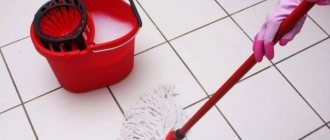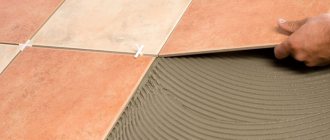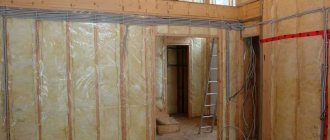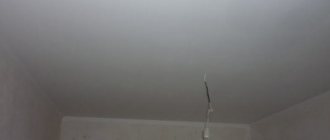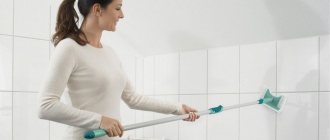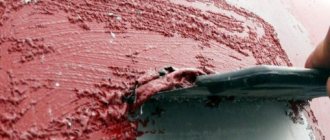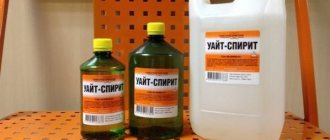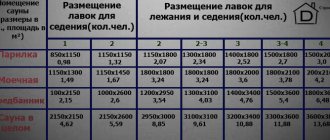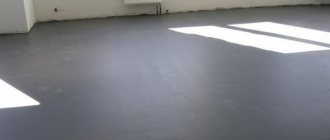06.09.201610.02.2017 Maria Ivanova 1 Comment
“How to wash a deep penetration primer, a building material that ensures the adhesion strength of the coating layers,” is a question that often arises after completing repair work on one’s own.
The painting craft seems simple only at first glance, but in practice, not only people who are not specialists in this matter, but also experienced craftsmen rarely manage to avoid side problems.
The result of significant physical effort and financial costs is not only a transformed apartment or some part of it, but also stained floor and wall tiles, windows and window sills, areas of linoleum or other surfaces.
If you fail to pay due attention to them in time, you have to pay with a more serious attitude towards the pollution that is not washed off later.
Meanwhile, there are effective and time-tested cleaning methods, using which, after repairs, you can restore the original state of a particular surface of the apartment.
Available means
There are many available products that can be used to clean white shoes.
Ammonia
Before working with this product, you should wear rubber gloves and a protective mask. To clean your shoes, do the following:
- mix ammonia in equal proportions with water;
- moisten a clean cloth in the solution and treat the contaminated areas;
- wash shoes by hand using powder;
- leave to dry.
Lemon
Lemon will help clean leather sneakers. To do this, squeeze out the juice of one fruit and mix it in equal parts with water. Wipe the shoes with a cotton pad soaked in the resulting mixture. Then it needs to be dried naturally. Lemon not only removes stubborn stains, but also helps refresh the material.
Chlorinated bleach
If yellow spots or stains appear on your shoes, you can use chlorinated bleach. It should be mixed with water in a ratio of 1:10. Then soak the product in the resulting solution and leave for half an hour. Then you can carry out cleansing procedures.
Lemon juice and baking soda
This is a universal remedy that helps remove the most difficult stains. To do this you should do the following:
- to make the product, you should mix 2 large spoons of soda and lemon juice to get a paste;
- treat contaminated areas with the composition and leave for 20 minutes;
- clean shoes from the composition with a clean napkin;
- wash the sneakers.
Vinegar + peroxide + powder
It is recommended to mix these components in equal proportions. Treat dirty areas with the prepared mixture. They should be moistened first. After 10 minutes, the sneakers should be rinsed.
What is primer and what is it used for?
Treating surfaces with a primer is considered preparatory work before final finishing. It is a highly viscous solution that forms a thin layer on the material, which is used to increase the adhesion of coatings. It contains various high quality components with film-forming properties. Modern primer is characterized by reliability, high manufacturability and a wide range on the construction market. For metal surfaces, among other things, the solution prevents corrosion and has water-repellent and antiseptic properties.
We remove primer stains from various types of surfaces
So, after some time you discovered stains from the soil on the linoleum or tiles, which you did not pay attention to during the repair. What to do?
The main methods for cleaning different materials are not universal and each specific case must be approached selectively. But remember that in the end, with effort, you can clean any surface.
Glass
First, you will need to acquire the latest tools, solvents, and rags.
If the stain is more or less fresh, then you can wet the sponge in plain water and gently wipe off the stain. If the substance has already dried, coat it with the same primer and allow the surface to absorb moisture. The stain will swell and can be wiped off with a damp cloth. If the stain is so dry that this method did not help, use a blade. It will help remove any remaining dirt. Move it in one direction without applying too much pressure to avoid scratches on the glass.
Particularly heavy stains can be removed using glass cleaners. For example, Dopomat or Hodrupa. These are low foaming concentrates, which are diluted in a ratio of 10 ml per 1 liter of cold water.
It is also helpful to have an abrasive sponge, T scraper, detergent, etc. All this can be an excellent help in the fight against soil stains on windows.
Tile
How to wash away soil contamination from tiles or tiles? Experts recommend that, if possible, first try one of the methods we propose on a sample of ceramic tiles that cover your floor or wall. This makes it easier to find the best option for removing the primer.
To complete the work you will need the following tools and products: tile cleaners, soda, scraper, vinegar essence, rags.
If the soil is dry, the stain can be removed using the same material. The stain wetted with primer will become softer and swell, then it can be wiped off with a regular rag. Finally, the area must be treated with an abrasive sponge soaked in water. Stains are rubbed off gradually, so don’t be upset if it doesn’t happen instantly.
Moistened and already swollen stains can be wiped off the tiles with any rag
If the dirt is so old that it cannot be wiped off with water and a cloth, then you can use a scraper. It can be purchased at a hardware store. This tool helps remove the remaining primer from the tiles by cutting them into small pieces. Pre-moisten the stain with water, and then, using progressive movements, cut it off with a scraper at an angle of thirty degrees.
Next, take a detergent and a sponge to remove small particles of soil that could cause damage to the tiles in the future.
Linoleum
It is better to wipe off a fresh primer stain from the linoleum as quickly as possible. If this does not happen, wet the stain with water and cover it with a wet cloth. After two to three hours, the stain should soften. It can be wiped off with an abrasive sponge and then wiped dry with a rag.
Plastic
Vinegar essence is a wonderful option for quickly and easily cleaning plastic surfaces from residual primer. However, remember that in this case it is important to take precautions, because the vinegar essence, when it evaporates, releases harmful substances into the atmosphere. For this reason, you need to work in overalls, gloves and a mask. And in the residential premises itself you will need to organize good ventilation
And in the residential premises itself you will need to organize good ventilation.
Do not use aggressive agents to remove primer from plastic.
Soil stains cannot be removed from a plastic surface (for example, a window sill or tabletop) with acids, otherwise it will simply melt.
The primer mixture is very caustic and will leave permanent stains if not dealt with immediately. However, if you notice the stain in time and wipe it off correctly, you can save any surface from contamination.
Universal methods
Universal methods are suitable for removing stains from various types of primer compositions and will help wash the primer from both the floor and glass:
- Fresh stains from almost any surface can be cleaned with a cloth soaked in water.
- Dried dirt should be thoroughly soaked, covered with wet rags and left for several hours. After this, the primer will be easier to separate from the surface of the glass or tile.
- The dried stain must be coated with the same primer that caused the contamination. After some time it will swell and can be removed with a damp sponge or cloth.
- Using a fine-grit abrasive pad is a good way to remove primer from tiles. But you should be prepared for the process to take a long time. Rushing will result in damage to the tile surface.
- A scraper or blade will help you clean glass or ceramic tiles with a smooth surface. Before starting work, it is better to moisten the dirt generously with water. To avoid scratches, removal is carried out at an angle of 45 degrees.
- You can wash plastic windows and PVC window sills from primer using a product such as polyurethane foam cleaner. The stains are generously moistened with the cleaning composition and then removed with a scraper.
- To dissolve primers containing coloring pigments, use acetone, white spirit, gasoline and similar compounds.
- Some types of primer can be cleaned with Mr. Muscle glass cleaner. Stains are removed best from smooth surfaces.
- The easiest way to clean acrylic primer from floor tiles is to pour boiling water over the stains and wipe with a sponge. This method is unlikely to work with other types of primers.
Before cleaning the tiles from the primer, it is advisable to test the chosen method on its remains, if any are available after the repair.
How to clean dried primer
Dried stains are more difficult to remove. There are effective ways to wash the surface of the primer: mechanical action, the use of chemicals and traditional cleaning methods.
Mechanically
Not suitable for glossy, acrylic tiles. The danger lies in the possibility of damaging the top layer of tiles and paint. The method is used for a matte surface. For mechanical cleaning you will need a scraper with a metal base or a sharp blade.
To clean the coating, you need to wet the primer with water or soapy water and leave for 6 hours.
The scraper or blade should be moved smoothly, tilted at an angle of 30-40 degrees, and rub the stain. When the base layer comes off, you need to wash off the remaining primer from the tiles with a sponge soaked in an abrasive cleaner with surfactants: sodium salt, metasilicic acid, baking soda, sodium tripolyphosphate, chlorine, pumice, chalk chips and other disinfecting components.
Abrasive means scrubbing. It is recommended to choose products with a soft composition so as not to leave scratches on the tiles. Softness depends on the size of the particles. Large ones are considered rougher, small ones are considered softer. Don't rub too hard, it will leave marks. You can wipe off any remaining primer using a dry cloth or paper.
Chemical means
Before starting the procedure, you need to wear rubber gloves to protect your skin. Otherwise, you may get a chemical burn. Use acetone, a flammable liquid found in paint. To clean the tiles, you need to apply the product to a sponge and wipe the dirty area 2-3 times.
The solvent works effectively in combating stains by breaking down the structure of the primer.
It takes 5-7 minutes to remove. The disadvantage is that acetone leaves a mark, erases the paint, and spoils the appearance of the tile. The recommended product is ATLAS SZOP. The product is considered universal, suitable for tiles and other surfaces - glass, wood, clinker. To clean the coating, experts advise using alkali, toluene, and turpentine. The compositions are similar to acetone and act more gently.
Traditional methods
You can clean it using traditional methods. To wash hardened primer from tiles, you need to dilute baking soda in water in equal proportions and wipe the stained area with a moistened sponge. There are no chemical compounds, the appearance of the tile does not deteriorate.
To clean tiles from hardened mortar, use vinegar. The liquid is hazardous to human health; the vapors released can burn the lungs; a highly concentrated product can damage the skin of the hands. Before using it, you must wear a mask and rubber gloves to avoid consequences.
Acetic acid diluted with water will help remove stains.
The solution should be carefully applied to a rag. You need to apply the cloth to the stained area and hold for 10 minutes. When the primer begins to become soft, rub vigorously.
You can wash off the residue with warm water.
White spirit is diluted with water and applied to the hardened primer. Experts recommend performing the procedure using a spray bottle. The liquid will be distributed evenly. If the solution gets on the wall, it will deteriorate the condition of the paint. Residues from the tiles can be scrubbed off with a scraper.
Acetic acid diluted in water breaks down wall finishing material. Citric acid may leave marks on the tiles. The product is recommended for use on matte tiles.
General rules
During cleaning, you should protect your hands with rubber gloves, and your respiratory tract with a respirator or mask. Dust released into the air during primer removal can be harmful to health, and cleaning compounds can cause burns or other damage to the skin.
Only suitable products should be used for each surface. So, you cannot use a steam cleaner on glass - uneven heating can lead to the formation of cracks in the material.
Removing primer stains from tiles and stone
Bright, contrasting stains from tinted primer are the most difficult types of stains. How to remove primer stains from tiles? In this case, you need to carry out a whole cycle of work. If the oil-based primer has had time to dry, then the first step is to clean it mechanically. Oil paints are elastic and difficult to remove from surfaces.
In addition, they have good adhesion to surfaces. Oil-based primer films are not resistant to heat, so it is better to warm up the area of contamination. Then, using purified kerosene or a solvent for oil paints, the stains are removed.
From laminate
Removing stains from laminate flooring is not easy, but it is possible if you take into account some nuances.
There are rules by adhering to which you can avoid damage to such an expensive coating:
- You should not use products with an abrasive composition and use a mechanical cleaning method, as scratches may appear on the surface due to coarse particles of the composition or increased friction;
- You cannot use certain types of solvents - their composition can be detrimental to the drawing;
- Long-term contact of water with the coating should not be allowed, as there is a possibility of moisture getting between the seams of the panels, which will invariably lead to swelling of the material.
To clean this surface, you can use dishwashing liquid, white spirit, nitro solvent 649 or 650 and nylon mesh. Dishwashing detergent is applied to the stain and the primer is gently scrubbed off using a sponge. For complete cleaning, wipe the dirty area with a damp cloth and wipe dry.
When using a solvent, first moisten the sponge, and only then rub off the stain, removing the residue with a damp cloth.
From window glass and tiles
The method for cleaning windows and tiles will depend on the type of primer. The easiest way to remove stains from these surfaces is from wallpaper glue, which is used to pre-treat walls before final wallpapering.
Fresh stains can be easily washed off with a regular rag soaked in water . For dried stains, pre-wetting is most suitable . With longer exposure to water, the adhesive substance swells, and the stain can be easily wiped off with a damp foam sponge. Then wipe the treated area dry with a handy product: a towel, rag, napkin.
Acrylic primer can be removed from floor tiles and window glass with water, especially if the stain is fresh. For high-quality wetting of the composition, a spray bottle is used. But if the primer contains dyes, then it will not be possible to wipe off the stain with water - in this case, it is better to use white spirit.
One of the most difficult primers to remove from glass and tile surfaces is the adhesive compound. In order to remove it from the surface, you will have to use mechanical force.
The best option for a glass surface is a blade.
The cleaning process must be carried out with the utmost care; the blade in relation to the soil formation should be at an angle of 40-45 degrees, so that it is convenient to pick up the edge of the composition and remove it without scratching the glass. After mechanical removal of contamination, the treated area is wiped with a cloth soaked in water and then wiped dry.
What to do if the plastic window sill is dirty
It is easy to wash the primer from a plastic window sill; the material is durable and is not subject to external influences, unlike tiles.
When using chemicals, the paint may peel off.
Optimal options:
- mix washing powder and liquid soap;
- Add a drop of toilet bowl cleaner to the water. The solution, which does not corrode plastic, can wash the primer;
- vinegar;
- sponge soaked in soda solution.
All cleansing options are similar. The difference lies in the cost and duration of the funds. Effective methods are folk and chemical methods of treating the contaminated area. Plastic window sills, tiles and other surfaces should be covered to prevent stains from appearing on them.
Primer is a substance that dries quickly. To wash the composition, you need to use special means.
The article has been verified by the editors
Possibility of resorting to proven means
A special paint remover is widely in demand to solve the problem, both in the case of processing linoleum and when working with surfaces of other types.
The best option: if there is no acid in the remover. You can also purchase one of the following solvents for this purpose:
- acetone;
- petrol;
- toluene;
- turpentine;
- ethyl acetate.
If it was not possible to completely cope with the problem, you need to perform a complete priming.
It is also acceptable to use:
- alkalis;
- acids;
- strong oxidizing agent.
The second of these options is acceptable for acid-resistant surfaces, including window glass. It is not recommended to use it when working with tiles.
A wider range of applications is characterized by a product such as alkali. The same applies to a strong oxidizing agent, which is allowed for cleaning tiles: the oxides present in its composition cause the absence of a negative effect.
Removing primer stains from tiles and stone
Bright, contrasting stains from tinted primer are the most difficult types of stains. How to remove primer stains from tiles? In this case, you need to carry out a whole cycle of work. If the oil-based primer has had time to dry, then the first step is to clean it mechanically. Oil paints are elastic and difficult to remove from surfaces.
All of the above methods for removing primer cannot be universal. You should choose based on the type of surface being cleaned. To make an unmistakable choice, it is better to test the chosen method on a small, inconspicuous area.
Plastic
The primer is relatively easy to wash off from a plastic window sill. You can use almost any method, with the exception of solutions with acid. They can cause serious damage to plastic. It is also not recommended to use hard sponges to avoid scratches.
Even the simplest detergents effectively clean plastic. You can use vinegar essence, alcohol, or any foam cleaner. The product “Silit” performs well. Contaminants are soaked with these products and then removed with a scraper.
Glass
In order to clean windows, a scraper is most often used. But before using it, it is advisable to soak the stains with any detergent or just water. To effectively clean plastic windows or similar surfaces, it is better to use foam cleaner or alcohol. Small stains and drops of primer can be easily removed with a nylon mesh or solvents can be used.
Tile
A more difficult way is to remove stains from tiles. A better result will come from using thick mixtures or solvents. They will allow you to clean not only the surface of the tiles, but also penetrate deep into the seams.
Linoleum
You can try to wash linoleum using the basic method - soak it with water and remove it with a scraper. You can also use a fine-grain abrasive sponge well moistened with water to clean individual segments. This method of removing soil is a little more complicated, but it guarantees the integrity and safety of the coating.
Traces, including those on linoleum patterns, can be thoroughly wiped off with a damp cloth, combined with baking soda. It is not recommended to use thinners or organic solvents to clean linoleum or laminate flooring. These floor coverings are not designed to be exposed to chemicals. Solvents will cause irreparable damage. To remove stains, use water-based cleaners.
Laminate
Laminate flooring can be cleaned similarly to linoleum. The most commonly used method is “treat like with like.” That is, the stains are covered with a primer of the same composition. Afterwards, wipe dry and wipe with a damp cloth or crumpled paper.
To avoid unnecessary hassle after repairs, you should carefully prepare before starting work. Protect all furniture and surfaces from contact with primer and other building materials. This will significantly save time, materials and work done.
How to wash acrylic paint, read on.
When carrying out repair work, the following rules must be observed.
- Surfaces that border the treated areas, but do not need primer, should be covered with cellophane. At the joints of the film you need to glue it with stationery tape.
- In order to prevent allergic manifestations or other consequences of the primer getting on the mucous membranes and skin of the painter, he must wear special clothing and a mask.
- Not all primers are environmentally friendly, non-toxic and odorless, so the room in which the walls and floors are being treated should be frequently ventilated if this does not violate the temperature regime required for priming.
Alternative Methods
A common question that worries owners who are renovating their kitchen is: how to clean tiles? Acid-glazed ceramics can be treated with a household plumbing cleaner. Glass cleaners will help solve the problem with other surfaces.
If the top layer is not smooth, it is recommended to use a hard sponge. The sponge will help in the fight for cleanliness on rough surfaces and is suitable for glazed tiles.
How can I remove primer from linoleum? Unwanted contours, particularly linoleum patterns, can be removed by vigorous movements with a damp cloth and baking soda. Well, highly concentrated vinegar will help after 1-2 weeks, removing primer stains from plastic windows, toilets and ceramic washbasins.
Vinegar is not the safest remedy. Without causing harm to the skin, the concentrate negatively affects the function of the respiratory tract. To prevent lung burns, you need to use a gas mask.
An alternative to vinegar is paint paint with a suitable filter. When working with the mixture, it is also advisable to protect the skin. Sometimes, in simple cases, you can get by with a household steam cleaner.
How to clean the tiles after completing the renovation?
It is almost impossible to protect walls and floors from splashes, drops, drips, and stains during finishing work. However, you can prepare for subsequent cleaning of the tiles. Moreover, this is not difficult to do, since the building material used during the work is known. For decorative finishing of the bathroom with tiles, use:
- adhesive solution;
- grout;
- primer;
- plaster;
- silicone sealant.
In addition, the tiles may have stains of lime, paint, foam, or traces of construction dust. The simplest algorithm of actions before washing the tiles involves:
- cleaning the walls with a vacuum cleaner from dust and adhering particles of building materials;
- scraping off frozen particles of hard building materials with a small blade or soft spatula;
- washing smeared construction mixtures with special solvents;
- wet treatment of walls with detergents;
- polishing tiles.
Removal products for most construction compounds can be purchased at specialty stores.
Adhesive solution and silicone sealant
Even with the most careful finishing work, excess adhesive will appear in the seams. They must be removed immediately with just a damp cloth and a spatula. If the mixture is dry, then:
- You can wipe off the tile adhesive after it has soaked under a damp cloth. To remove polymer glue, the fabric is moistened with a solution of acetone, ammonia, and vinegar. A solvent will help remove epoxy adhesive stains.
- You can try to remove dirt mechanically. To do this, use sandpaper, a stiff brush, or a scraper. You must act extremely carefully so as not to spoil the glaze layer.
- Porous ceramics will be more difficult to clean because... the compositions eat deeply into the structure of the finishing material. In order to select the right solvent, you should know what kind of glue was used. On the packaging of building materials, manufacturers indicate a solvent suitable for cleaning.
Silicone sealant, used to seal joints (for example, between a bathtub and a wall), protects against moisture and prevents the development of fungus and mold. To ensure accurate application of the sealant, it is recommended to protect the surfaces with masking tape.
This building material firmly adheres to any surface, and it is extremely difficult to remove dried sealant. It will have to be cleaned mechanically (scraper, blade) or chemically (white spirit). Both methods are dangerous for adjacent surfaces; the result can be scratches, chips, areas corroded by chemicals with disruption of structure, color and loss of shine.
Removing primer and cement
These construction mixtures are also easier to clean up right away. This requires no effort, just a wet cloth. If dried stains are found on the tiles after completion of construction work, then the first thing you need to do is try to soften them. Moreover, you can try to moisten the primer stains with fresh primer and then scrape them off with a scraper. For cement, a rag and scraper moistened with hot water will do.
Grout
Most often, the tiles in the bathroom after renovation have to be cleaned of grout. The use of a grout mixture is the final stage of finishing work. Experienced craftsmen seal the joints and remove excess mixture at the same time, while trying not to smear the composition on the tiles, and carefully wipe it with a dry and damp sponge.
Dried grout stains are washed off more easily than an adhesive solution, but the procedure will have to be repeated several times. After the top layer has dried (the seams become lighter), the wall should be moistened with clean water and then rinsed off with another clean sponge.
If epoxy grout was used, then you cannot do without a special solvent.
How to prevent soil stains on walls and floors
Don’t think that painting is a simple matter. Often, even experienced builders stain linoleum or floor tiles, as well as window glass or window sills with primer. And if such stains are not washed off immediately, then over time they turn into a rather complex problem.
To avoid such difficulties after renovation in a country cottage or city apartment, you can try to protect the surfaces as much as possible from the risk of staining them with primer. How to do it?
Regular cellophane is a good way to protect against unnecessary stains
Just adhere to the following rules when performing all repair work inside a country cottage or city apartment:
- To prevent the solution from getting on various surfaces that do not need priming, you need to completely cover them with cellophane. Be sure to glue the joints with regular stationery tape;
- To protect yourself from allergic reactions and other health-related complications, be sure to carry out all work in protective clothing and a mask. Also ventilate the room regularly, because the soil has a pungent odor.
Five means and methods for removing soil
Methods for removing primer can be divided into two types: cleaning with special means, solvents or by mechanical action. It is better to choose each method based on the composition and properties of the primer material. Therefore, do not neglect the instructions. Careful attention will help to avoid damage to the surface being cleaned.
Method 1. Soak
The easiest, fastest way is to use a wet rag or sponge. But it will only help if you apply it immediately after applying the primer.
If a couple of hours have already passed, you should try to soak it. To do this, apply a sponge or rag generously moistened with water to the stain and leave for half an hour. It is necessary to add water periodically to prevent the stain from drying out. During this time, the primer will swell slightly, making it easier to clean. Contamination is carefully removed using an abrasive sponge.
Attention! Water brought to a boil begins to interact faster with the primer material, making it easier to remove
Method 2. Scraper
After soaking, you can try to clean the primer with a scraper. This is a tool that looks like a blade with a handle and is sold with spare parts. You can find it in every hardware store. It allows you to wipe away dirt from linoleum, tiles, glazed tiles or wood.
Method 3. Soda
Soda has long been used to clean various objects. The easiest way is to dilute the powder in a small amount of water, and try to wash off the primer with the resulting mixture.
Or you can prepare the composition according to the recipe: baking soda is mixed with oatmeal in equal proportions. Stirring constantly, the mixture is diluted in water until it becomes mushy. The solution is applied to the stain and left to soak for about an hour. Then remove with a sponge with an abrasive pad.
Method 4. Treat like with like
The dried primer gets wet well and even dissolves if the same primer material is applied on top. Cleaning should take no more than 20 minutes until the new layer has hardened. Then everything is thoroughly wiped with a rag or sponge. If the composition is difficult to remove, try using a scraper.
An important point: you need to select a primer with an identical composition to the one you want to scrub off. Therefore, this method is not always appropriate.
Method 5. Special equipment
All special products can be divided into two groups: household chemicals and aggressive compounds containing acids. The simplest solutions include conventional glass cleaning agents. For exposure, they are left for about 15 minutes, then removed with a sponge. Acid-free solvents are also used: gasoline, acetone, alcohol, turpentine, 646, toluene, ethyl acetate. If these methods do not give the desired result, then resort to professional chemistry:
- Hodrupa and Dopomat concentrates. These liquids are similar in quality and composition. Before use, they must be diluted with water in the proportions specified in the instructions. In exceptional cases, use undiluted concentrate to achieve greater effect;
- Atlas Szop is considered the most effective remedy. It can even cope with dried stains of cement, plaster, and lime. However, due to the content of inorganic acids in it, the composition is not suitable for acid-resistant surfaces. It can be used for stone, ceramic, varnished, chrome-plated, clinker, and artificial materials.
Do not neglect the instructions. The effectiveness of these compositions is combined with the risk of damage that may occur if even the slightest traces of these solvents remain.
Final Recommendations
In order not to wash off stains from glass, plastic and other surfaces in the future, it is highly desirable to prevent the primer from getting into areas not intended for treatment with this building material. The primer improves the adhesive properties of plaster, paints and varnishes, etc., which in our particular case is only a drawback.
Fearing that the stains will not be removed, you should not abandon the primer altogether: without it, the walls will soon crack and the wallpaper will peel off.
Physical and financial costs will be useless if the final result of a beautiful renovation, the memories of which are quickly washed away from memory, collapses before our eyes within a couple of months. In this regard, professionals insist on using soil during the repair process. Products with certified quality certificates are highly effective.
It is worth paying attention to the effect of the material on the human body, preventing the occurrence of allergic reactions. It is necessary to constantly ventilate the room so that the feeling of the presence of a pungent odor is completely removed.
Before starting repair work, it is extremely important to pay attention to studying the order of preparatory and post-repair operations. It is important to protect yourself when you have to clean the primer with a scraper or other sharp objects. Accordingly, the primer material in undesirable places is not easily wiped off, but with some effort it can still be cleaned.
Eliminating smudges from primer (2 videos)
What is useful for cleaning the surface (20 photos)
How to remove primer from ceramics
If preventive measures do not help, and the primer solution still gets on the ceramics, you need to wash it off the lining without delay. If a stain is detected in a timely manner, you can wash it off the surface of the tile with plain water and a clean cloth.
After about 30 minutes, the deep penetration primer begins to set and wiping it off with water and a rag will most likely not work; you need to resort to more radical methods. One of them, which also does not require special expenses, is to try to wash off contaminated stains with the same composition of the primer, the product that was used to carry out the repair work, and which became the source of contamination. The cleaning process looks like this:
• on stains and traces of primer, apply a small amount of the same composition; • after softening the contamination, you need to remove the primer from the tile; • then, on the problem area, you can put a wet rag to completely swell the primer and then remove it with a hard sponge moistened with water.
How to wash primer - known methods
There are a number of other methods that allow you to wash deep penetration primer mixtures on ceramic tile cladding: • Mechanical method. The method is applicable to tiles that have a smooth, glazed surface. Primer stains are cut off with a special scraper with sharp, replaceable blades, but before this procedure, the contaminated area must be soaked in water to soften it and make it easier to remove. • You can also wash away traces of primer using a foam cleaner; the product is applied to the desired location, the dirt is softened, and then removed from the tile with a sponge.
You can wash the primer from plastic tiles with alcohol or foam cleaner • If the ceramic tiles of your cladding are resistant to acids, then you can use Atlas Szop. This is a fairly strong composition that can remove dried stains from primer, tile adhesive, cement and ceramic surface grout. Atlas Szop is used to clean tiles from lime and cement stains and stains • For tiles that are not resistant to acids, you can use gasoline, acetone, turpentine, white spirit or paint remover containing acid for cleaning. • Tile, with a glazed surface that is indifferent to acids, can be cleaned with household compounds used to care for plumbing fixtures. • Tiles with a corrugated surface can be successfully wiped off with a hard sponge or a damp cloth with plenty of baking soda.
What other methods and means exist for removing primer from tiles? Among the folk remedies for cleaning ceramics from primer stains, one can highlight the use of vinegar essence, and a radical method is the use of a steam cleaner.
When using strong household chemicals, the ceramic surface after treatment must be thoroughly washed with water and detergents. Otherwise, concentrated substances may damage the front side of the ceramic.
Ceramic
Poker chips have replaced clay chips and are now used in Las Vegas casinos and other famous casinos around the world. But luck does not depend on the quality of the chips, and you can see this here play777-slots.com/
What is the root of the problem
Deep penetration primer consists of polymers, water or solvents. After its application, water and solvents begin to quickly evaporate, and the polymerization process occurs. As a result, the material becomes practically insoluble. Due to this, the quality of surface adhesion increases. At the same time, problems arise in eliminating errors in the use of a primer.
Contamination can be easily removed within 30 minutes after application of the material using a wet sponge or rag. Within 2-3 days, errors can be removed using special means. After a long period of time, it is almost impossible to completely remove flaws.
Attention! The most prompt actions contribute to quick, high-quality, and easy achievement of results.
The most important, reliable recommendation is preparation before painting work. All surfaces not intended for priming must be insulated as much as possible. For protection, cover film or cellophane is used, and the joints are sealed with masking tape or tape. Also, do not forget about your own safety, purchase gloves, a face mask and protective clothing.
In practice, many people miss this important stage, including due to ignorance of simple protective measures. As a result, the task arises in finding methods that can remove the primer.
Folk remedies
You can make your own equally effective tile cleaning products. The components of folk remedies do not act as aggressively on the treated surface as chemical industry products, so removing stains will take longer.
But such compositions do not contain substances hazardous to health and the environment, which allows them to be considered a good alternative to household chemicals for people who suffer from allergies or have small children.
The preparation of any composition requires compliance with proportions. It is more convenient to apply them using a spray bottle.
Vinegar
The most common cleaning product among housewives, which can be used for both daily and general cleaning.
Vinegar removes any dirt, incl. calcium deposits and rust, disinfects surfaces. 1 part of the essence is diluted with 10 parts of water, applied to the walls using a spray bottle and left for several minutes. Then rinse off with clean water and wipe the tiles dry with a microfiber cloth.
Table vinegar 6%, diluted in equal proportions with water, can be used daily to prevent the formation of mold fungi.
Soap
Soap is the worst enemy of glossy ceramic tiles. It forms a thin film of fat on the tile, which is not so easy to remove. The fatty base of soap can provoke the appearance of mold fungi, which will be difficult to get rid of.
Instead of soap, it is better to use dishwashing detergent, which perfectly removes grease and dirt. And then apply a composition designed to combat rust, mold or other contaminants.
Soda
Baking soda will help get rid of limescale. It should be used carefully, without using force when applying, because... solid particles may scratch the tile surface. You can soften the powder by bringing it to a paste using a liquid component.
To remove dirt and mold from the seams, use a toothbrush to rub in a paste of baking soda and water. After treatment, just rinse off the applied composition with clean water and wipe the surface dry until shiny.
You can dilute soda powder not only with water, but also with bleach or any bleach.
Lemon acid
You can restore the shine to dull tiles and eliminate mold spots using citric acid. Using a damp sponge, rub the dry powder into the contaminated areas, and after 3-5 minutes, wash off with clean water.
An alternative is to wipe the seams and dirty areas with fresh lemon juice (half a fruit).
Ammonia
Pharmacy 10% ammonia solution is ammonia. The product has a characteristic pungent odor, so when working with it you should definitely use a respirator to protect your respiratory tract.
If you dilute 1 tbsp. l. ammonia 1 liter of water, then you can get a universal household cleaner. Experienced housewives use this solution to wash mirrors, windows, and crystal. Ammonia will help and restore the original appearance of the tiles.
You can strengthen the aqueous solution of alcohol with vinegar by adding 1 tbsp. l. The mixture should be sprayed over the surface with a spray bottle, and after 5 minutes, rinse with water. Polish clean tiles with a soft cloth.
Chlorine
It has a pungent and persistent odor and is irritating to the respiratory system and eyes. But at the same time it is considered the best means for cleaning white tiles and disinfecting the room. Before cleaning mold from colored tiles and grout, the effect of even a weakly concentrated bleach solution should be tested in a place hidden from view.
Borax
Used as a component of many detergents. Effective in deodorizing and disinfecting premises. To clean tiles, borax powder is applied to contaminated areas and tile seams using a damp sponge.
The use of potent compounds
The need to use potent compounds arises when removing dried stains. Several chemical solutions have become popular in the market.
Veroclean
Veroclean is highly effective and produces minimal foam. Residues of raw materials can be removed through short-term exposure. Veroclean is only used on waterproof surfaces.
Powerflix
Powerflix, based on phosphoric acid, does not damage the coating and dissolves building material residues. When using the composition, it is important not to allow it to dry out. It is recommended to ventilate the room well during and after work.
Hodrupa
Low foaming Hodrupa cleaner is used on water- and alkali-resistant coatings. The product cleans raw material residues and does not lead to corrosive destruction
Atlas Zsop
Atlas Zsop is suitable for removing dried residues and dirt after repairs. The product can be used on the outside and inside of buildings. Due to the presence of inorganic acid, it is not recommended to use Atlas Zsop to clean primer marks on enamel and marble.
Dopomat
Dopomat fast-acting cleaner is designed for treating floor coverings. The product abundantly wets the surface and does not leave foam or streaks. Dopomat is suitable for cleaning after renovation and for everyday use.
Corvette
Corvette's highly alkaline solution penetrates into porous structures and removes residue from waterproof tile surfaces. After treatment, mechanical cleaning of contaminants is required.
What are the types of stains on the windowsill?
To avoid having to think longer about how to remove stains from plastic window sills, wipe the dust off them daily with a dry soft cloth and wash them once a week with water and some cleaning products.
- To eliminate light stains, dissolve a spoonful of dishwashing gel or a little regular powder in 1 liter of warm water.
- Stir thoroughly until foam forms, soak a sponge in it and walk along the windowsill.
- Then remove the foam with a damp cloth and wipe the surface dry.
When a room or kitchen undergoes renovation, the question of how to clean a plastic window sill from stains and dirt becomes more pressing. Dust and construction dirt accumulate on it in huge quantities, and serious means are needed to remove it.
Most often, housewives encounter the following marks on the surface of the window sill:
- yellow blots left after watering flower pots;
- traces of grease and stubborn stains from dirt and rust;
- contamination from glue or adhesive tape;
- frozen drops of primer, polyurethane foam and stains from other repair work.
If there is a child in the house, most likely you will need a product on how to remove stains from a plastic window sill from crayons, markers or pencils.
Why do you need to prime the surface?
- Subsequent finishing materials are placed on a primed surface with better quality.
- The primer extends the service life of the coating.
- A deeply penetrating primer mass can regulate the porosity of the base and strengthen it.
- After penetration, the primer prevents wear of the material and protects against corrosion.
- Masking of minor defects.
- Primer mixtures for painting, puttying, and varnishing significantly reduce the consumption of finishing materials.
Cleaning windows
Very often people have a question about how to clean windows after repair from primer. We can tell you exactly how not to do this. If you come up with the idea of using any sharp objects, then immediately throw them aside.
Sandpaper will also not work, because it will scratch the surface of the window. You shouldn’t use a steam generator either, even though it is effective, because if the temperature changes, the window will quite possibly crack.
The glass surface is easiest to clean; any solvent, vinegar or gasoline will do. They will in no way damage the surface of the glass; wipe the glass with a soft cloth moistened with one of these substances.
